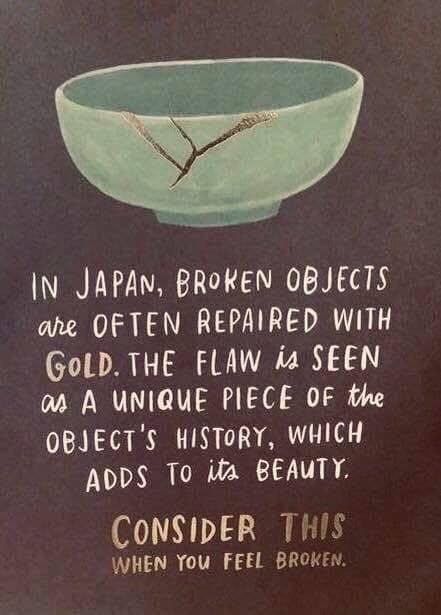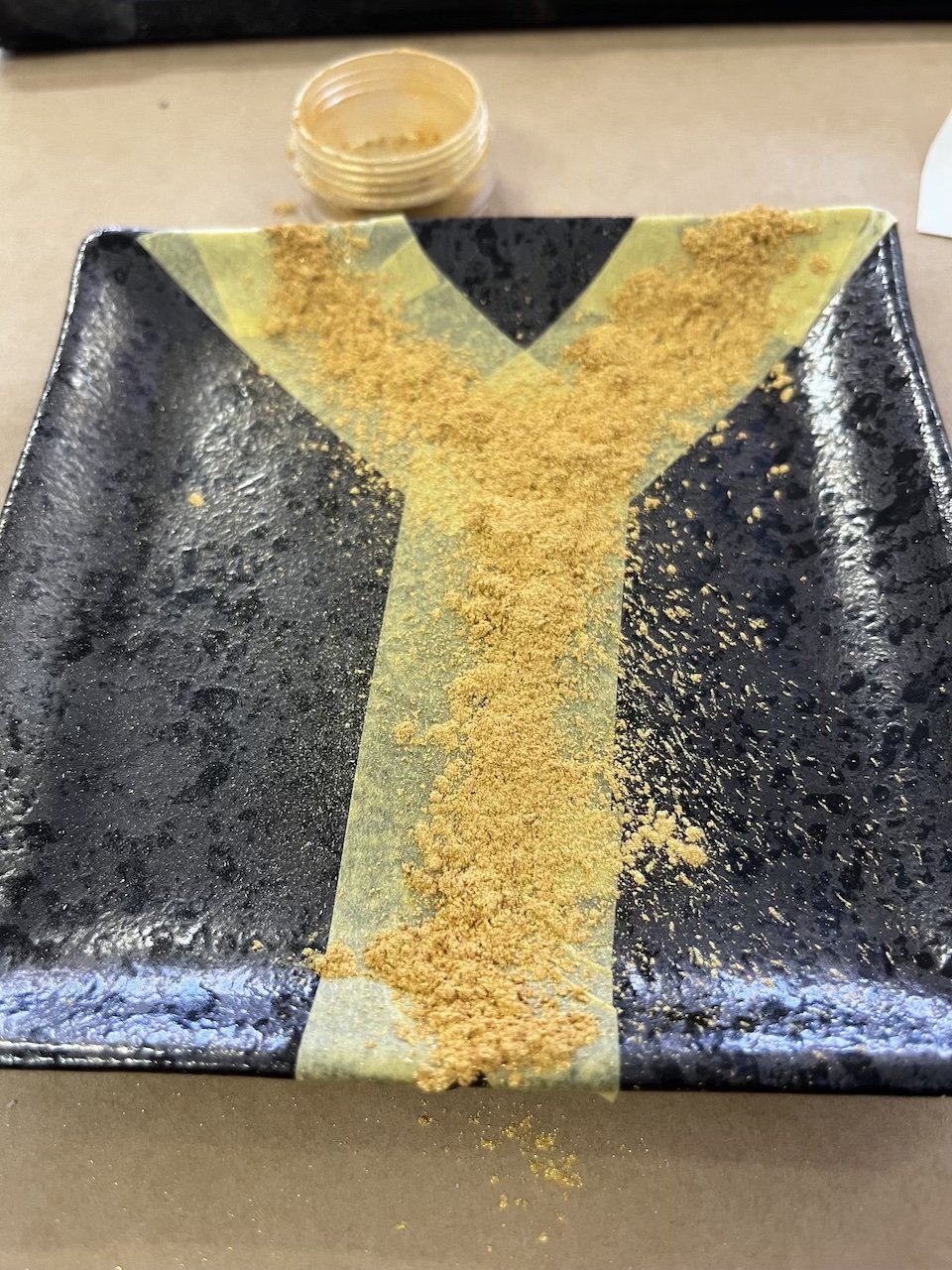Healing Trauma, Lessons From The Japanese Art Of Kintsugi
Healing Trauma, Lessons From Kintsugi
In Japan, broken objects are often repaired with gold. The ‘flaw’ is seen as a unique piece of an objects history, that adds to its beauty. What the ancient art of Kintsugi can teach us about healing trauma and seeing beauty in our ‘imperfections’
Recently I attended a Kintsugi class and I wanted to share some of my learning and reflections.
The philosophy of Kintsugi believes in the beauty of imperfection which resonates with my own philosophy around healing and processing trauma. Now feels like a good time to be talking about Kintsugi as I've been having a lot of conversations recently where people have expressed feeling 'broken', feeling deep shame and not good enough. All of which are often part of the impacts of trauma.
If you haven't heard of Kintsugi, it dates back to the Muromachi period (1338-1573) and is a form of Japanese art.
During this time, the Shogun Yoshimasa Ashikaga found a crack on one of his treasured tea bowls and in hopes of getting another bowl to replace it, he sent the bowl back to China where it had been made. However no one was able to remake the tea bowl and no replacement could be found.
So the piece was sent back to him with a clamp on it…
It is said that Yoshimasa was not pleased with this and ordered his craftsmen to find a better solution…
This is said to be the beginning of Kintsugi in Japan. In Japanese, Kin means gold & Tsugi means join together.
After my Kintsugi class I came away with a deeper understand and appreciation for the art of Kintsugi and I wanted to share some of my reflections.
In my class, we were all given a plate that had been broken into three pieces.
The first thing we needed to do, was to file the edges of the broken pieces.
Something important to note is that it impossible to change the shape of the broken pieces…and actually we don't want to change their shape…. because if we did, the pieces will never come together and be whole
Similarly in our healing work, it is not so much about completely changing or getting rid of parts of ourselves (even the parts we might wish didn't exist). Instead, it is about working to accept and understand ALL parts of who we are. Recognising that each part is valuable. It is from this place, we can begin working with all of our parts, appreciating all parts are needed to make us whole.
The filing process works to adjust the thickness of the lines between the joined pieces. It's through this process of filing the grooves that the broken sections will get their curves that will eventually be filled with gold.
Therapy is a bit like this filing away process. It is not always exciting, it takes work, effort and focus, but the work begins our process of change, growth and transformation.
The next step is to join the broken pieces.
Each piece is carefully joined one at a time with special epoxy glue. This process takes time. It's delicate, gentle and slow. You can't rush the process and you need to focus on not using too much or too little glue as you apply it to the edges.
In the beginning, you are trying to find the balance! You might use too much glue or not enough glue. However, it's not a problem, because you have a little tool to tidy and scrape the excess glue off and you can always apply more glue…
You see, there are no mistakes in Kintsugi
Therapy is like this too. You cant do it wrong, there is no mistake you are making, it's a process of finding what fits, experimenting and seeing what works and what feels right for you. There is no one single path to healing.
It's about respecting that each person's process may be a little different and that each may need different things. Regardless, we respect the process, we work gently and with care, finding the balance of safety and risk.
Not forcing too much, not doing too little.
As the glue is drying some tape is added to help keep the pieces in place.
After all…we need a little support as we heal and mend, change may not ‘stick’ straight away.
Masking tape is then applied 0.5mm from the groove lines, as a putty is prepared to fill the groove lines. The masking tape helps you keep the putty in the right place and you use a little tool to go over and smooth everything out. Once again, this is delicate, slow and precise work (are you getting the message?!)
The Kintsugi teacher also explained that some people would say they do kintsugi without taking the time to get the right amount of putty into the grooves, and to tidy it. Some people would simply paint over the lines…
But doing this without all the steps, attention to detail, care and respect is NOT the art of Kintsugi.
Similarly when it comes to healing and trauma, creating long term sustainable change and transformation does not happen through a quick fix or a one-off magical intervention.
The work is not about brushing over what is important. We need to treat and heal the pieces that call for our attention, with the same diligence care and respect.
We need time to integrate new experiences and learnings, we need to embody them rather than brushing over them or just getting something on a cognitive level.
Yes I'm speaking to those of you who believe you ‘should’ be better, further along, more ‘normal’ (whatever that means?!)
Kintsugi's philosophy says scars should not be hidden. Instead it is about acknowledging that breakages and repairs form part of our history. The art of Kintsugi is the process of treating and healing the scars…to then be able to see the gold. It is the scars that beautify the object.
Next, masking tape is applied again, as close to the groove lines that have been made as possible, making sure not to cover the lines! A base coat with a small amount of gold is applied first.
Then a brush is used to scoop the gold powder, and you gently tap the brush, letting the gold powder be sprinkled onto the lines. Any excess gold powder is also collected, so as not to waste any of the materials.
When the dust on the lines has settled so to speak, the excess gold powder is gently brushed off, to reveal the transformation.
The piece is more beautiful, It is still what it was, still familiar, yet somehow different.
This process reminds me that in our healing journey we are collecting little moments of gold as we transform.
There are ah-ha moments, new awareness, experiences, beliefs. There are moments that perhaps only on reflection we can see as gold. These moments of grief, pain and emotion as well as courage, triumph and transformation.
And through our process, we find that we have changed, transformed somewhat, somehow the same, but also different. Acknowledging the beauty of imperfection, of all the pieces of ourselves, seeing the gold.
Thomas Navarro said:
We humans are fragile; susceptible to breaks and knocks
Discover how to pick up the pieces and repair what may have been damaged in your life
Find out how to embrace your emotional scars and make them beautiful
They are proof that you have suffered…
( and I'm adding my own last line)
Let them remind you of the power of the human human spirit, and it's will to triumph and survive.
There were so many insights I had in my class and writing this email! I would love to hear your thoughts and if the philosophy of Kintsugi resonates with you too?











